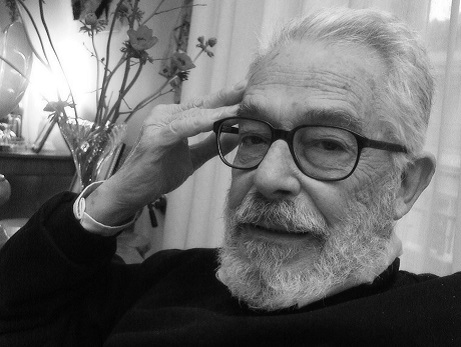Biography
Caniaris was born in 1928 in Athens,where he died in 2011. Shortly after graduating from the School of Fine Arts in Athens, he moved to Rome, where he left behind his previous representational style and started to experiment with everyday materials such as metal mesh, wire and plaster in a similar manner to his Italian contemporaries Lucio Fontana and Alberto Burri. In the works “Homage to the walls of Athens”, where the walls of Athens are represented by the palimpsest and slogans are buried underneath the whitewash plaster, the artist revealed his political and social concerns and moved a step towards realistic political art (Konkreter Realismus). By the time of his “Space Within Space” series (1960), Caniaris had abolished the strict limits of his canvases. The incorporation of diverse materials onto the canvas transformed these paintings into sculptural objects that acted in dialogue with the space surrounding them. Soon, the addition of preformed objects and mannequins into his works absolutely confirmed the artist’s suggestion that “the works should be what they are, not a representation but a real object within the space.” In 1969, just two years after the abolition of Greek democracy by the Colonel’s dictatorship, Caniaris’ exhibition at the New Gallery in Athens, featuring works cast in plaster, provoked sensational reactions. The artist was forced by the regime to leave Athens for Paris, where he worked closely with the Nouveau Réalistes, whose art was seen as Europe’s answer to American Pop. “The collective awareness engendered by the New Realists, of modern, industrial, urban and tempered nature, were all at the starting point of a broader movement of appropriative recycling (sic) of the real… You were one of the protagonists. Your sculptural assemblages made out of household objects, fabric, worn-out clothes, were in direct reference to the social prism of our post-war era, seen through the visual angle of a Mediterranean culture” their founder, Pierre Restany, wrote to Caniaris in 1999. Yet despite being considered as a pioneer of New Realism, Caniaris never fully identified with the movement. In the early 1970s Caniaris relocated to Berlin and started working with “environments”. Presented in several German museums (Hannover Kunstverein, Kunstverein Heidelberg, Κunsteverein Ingolstadt and Musuem Bochum) and at London’s ICA, his new body of work, “Immigrants”, was a reproduction of the world of the workers who streamed into Germany from other, mostly Balkan countries. In 1979-80 Caniaris staged “Hélas-Hellas” (The painter and his model) at the old Fix Brewery in Athens. Created mostly in-situ, the work was a narration of everyday public life in Modern Greece and took over the 1,500 sqm of the deserted factory. The first figure encountered by the viewer in this environment was the painter; the artist as a witness and recorder of an objective reality, in direct reference to paintings like Velazquez’s Las Meninas and Courbet’s Artist’s Studio. In Hélas-Hellas we see political demonstrators, lottery ticket sellers, apathetic observers of the events and illicit readers of newspapers set amidst a backdrop of smoking grills, public urinals and hanging drying clothes. Vlassis Caniaris lived and worked in Athens until his death in March 2011. He has presented his work in many solo and group shows, notably the 10th Gwangju Biennale: “Burning Down the House”, South Korea, cur. Jessica Morgan (2014), «The Encyclopedic Palace», 55th Venice Biennial, Arsenale, Venice, curated by Massimiliano Gioni (2013), his solo exhibition at GAK Gesellschaft fur Aktuelle Kunst in Bremen (2012), the retrospective exhibitions dedicated to him at the National Gallery of Athens in 1999, the State Museum of Contemporary Art, Thessaloniki in 2000, the Karl Ernst Museum, Osthaus in 1991, and the Moderna Museet, Stockholm in 1971, as well as a solo show in the Staatliche Kunsthalle, Berlin in 1991. More recently, the Benaki Museum, Athens mounted a solo show in 2008. In 1996 Caniaris participated in the exhibition “Face à l’Histoire: 1933-1996” at the Centre Pompidou, Paris. In 1988 he represented Greece at the Venice Biennale together with Nikos Kessanlis, and in 1977 he exhibited at Documenta 6, Kassel. Public collections include Tate Modern in London, SMAK Stedelijk Museum voor Actuele Kunst Gent Belgium, Musée d’Art moderne de Saint-Etienne Saint-Etienne France, Osthaus Museum Hagen, National Art Gallery – Alexandros Soutzos Museum Athens, National Museum of Contemporary Art – EMST Athens, MMCA Macedonian Museum of Contemporary Art Thessaloniki. Other recent exhibitions include: “The Encyclopedic Palace” 55th Venice Biennial (curated by Massimiliano Gioni), a solo exhibition at GAK Bremen and a solo presentation at Henry Moore Institute in Leeds. Upcoming exhibitions include the 10th Gwangju Biennial, curated by Jessica Morgan.



